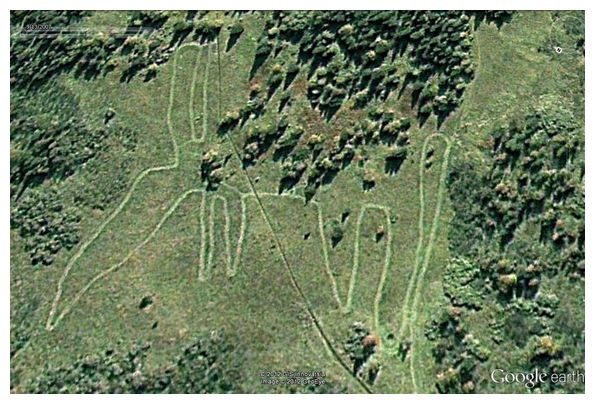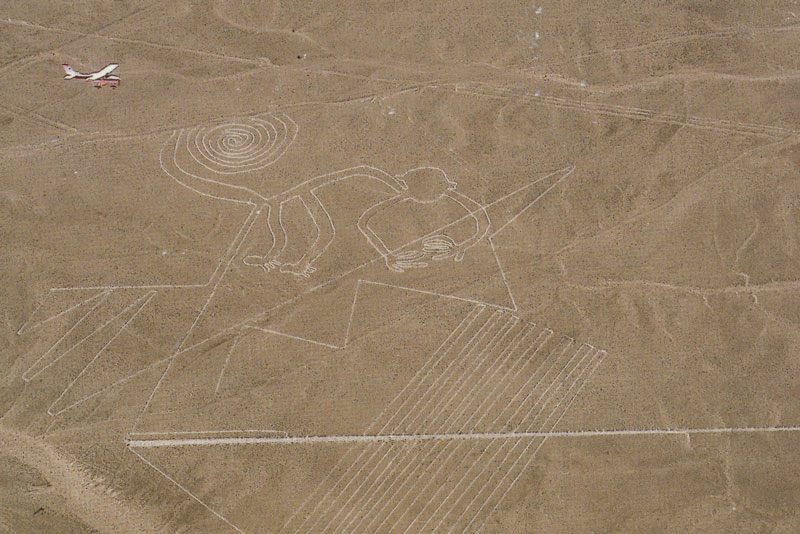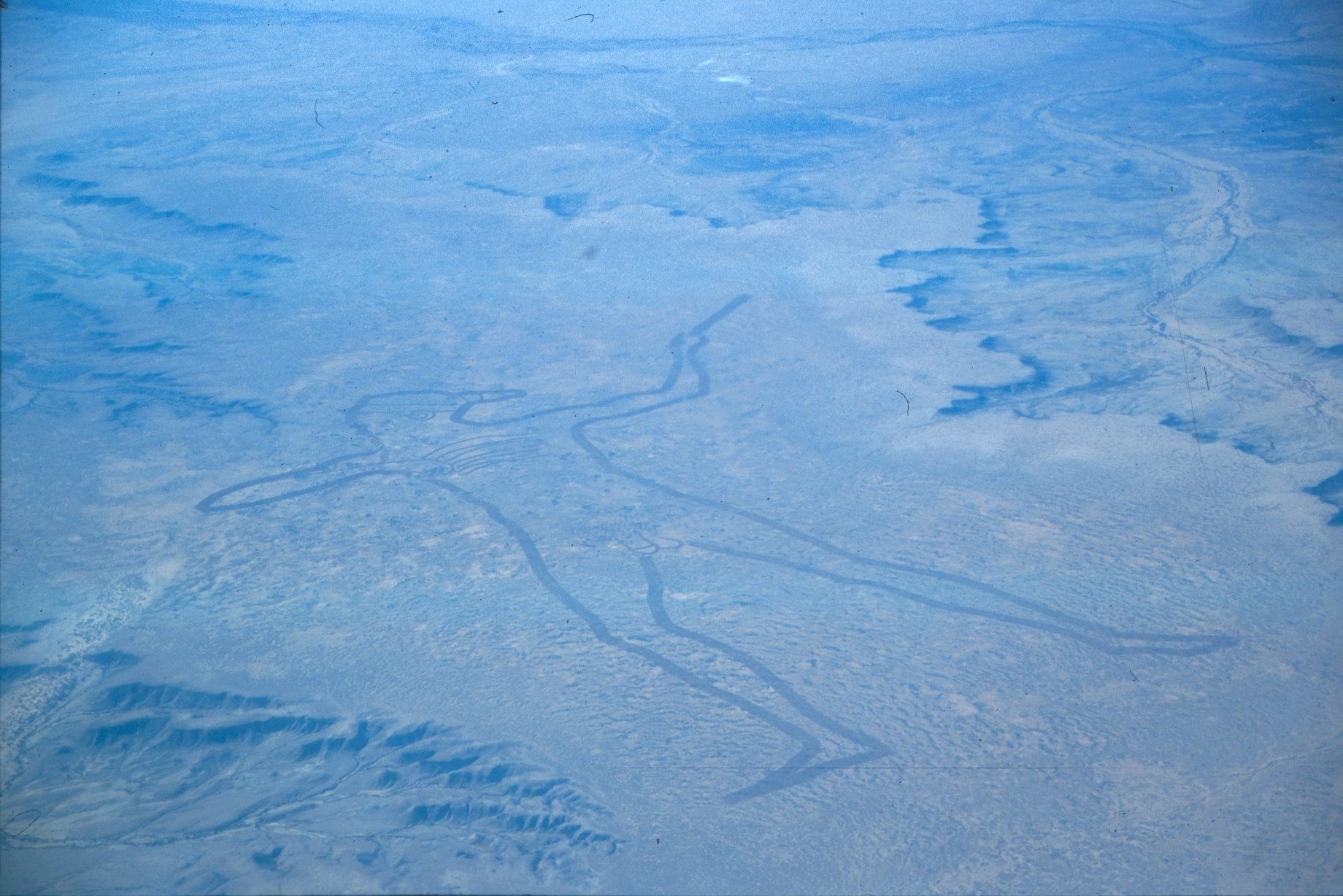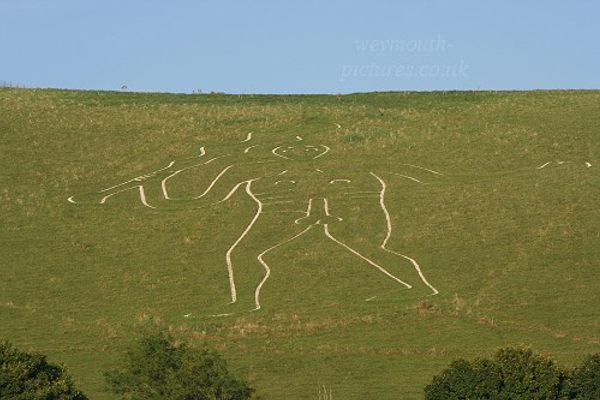Monkeys, Moose, and Britain’s Most Famous Phallus: Geoglyphs From Around the World
 Russian moose geoglyph (image via sott.net / Google Earth)
Russian moose geoglyph (image via sott.net / Google Earth)
In Russia’s Zyuratkul National Park is the world’s oldest geoglyph — a large work of art made by arranging stones, earth, or other objects within a landscape. The massive figure, about the size of two football fields, was constructed between 4,000 and 3,000 BCE but wasn’t discovered until 2012. It was created by digging trenches and filling them with large and small rocks chipped from a nearby ridge made of white quartzite; viewed from the top of that ridge, the figure would have stood out starkly against the green grass. Surprising new evidence indicates that it was built by everyone in the Neolithic community — including children. Archaeologists at the site have uncovered 155 tools, mostly used for breaking up stones, in a variety of different sizes, including those that could only be held by tiny hands.
Little is known about the ancient civilization that created the glyph, but a senior researcher on the project told the Siberian Times that this discovery is not an indication of anything untoward like child slavery; children “were involved [in the work] to share common values, to join something important to all the people.” This is consistent with findings about geoglyphs around the world, which are all believed to have had ritual, cultural, or religious significance for ancient peoples. (Unless, of course, they were actually made by aliens, a theory that continues to crop up.)
Here are several other famous geoglyphs, all of which lead to more questions than answers.
Nazca Lines, Peru

Nazca monkey (image via Steve Taylor / Flickr)
By far the most famous geoglyphs, the Nazca Lines stretch across nearly 200 square miles of Peruvian plateaus, depicting hundreds of creatures: whales, hummingbirds, monkeys, spiders, and many more. The catch is that these figures are so huge that they can only be seen from a few hundred feet in the air — far higher than the ancient Nazca who made them would have been able to ascend in circa 400 to 650 BCE. The figures have been a source of extreme fascination for hundreds of years, but despite examination by an endless array of anthropologists, ethnologists, and archaeologists — not to mention new-agers, ancient astronaut theorists, and alien enthusiasts — no one knows how they were made or why. Theories include that the lines marked a procession route that the Nazca would walk during ceremonies, that the figures represent a giant astronomical calendar pointing to the locations where celestial bodies would align themselves, that the Nazca might have built hot-air balloons from which to view the glyphs, and that the lines are actually communication with or landing strips for ancient aliens or astronauts.
Blythe Intaglios, United States
 One of the Blythe Intaglios (image via Rob’s Log / Wikimedia)
One of the Blythe Intaglios (image via Rob’s Log / Wikimedia)
Anthropomorphic geoglyphs are also known as “intaglios.” There are around 300 of these in the American Southwest and Mexico, and the most well known are located near Blythe, California, in the Colorado Desert. Included in the Blythe Intaglios are six figures in three locations; each location has at least one humanoid figure and one animalistic one, and the largest of the figures is 171 feet long. As with most geoglyphs, these intaglios are much too large to be visible from the ground, and although they are believed to have been created in 1000 CE, they were not rediscovered until 1932.
Cerne Abbas Giant, England
 Cerne Abbas Giant (image via PeteHarlow / Wikimedia)
Cerne Abbas Giant (image via PeteHarlow / Wikimedia)
Yes, this ancient giant is sporting an giant ancient (36-foot-long) hard-on — it has been called Britain’s most famous phallus and is believed by some to have fertility powers. Many couples hoping to get pregnant go there to have sex on the figure’s penis. The Giant’s origins are not clear; it is assumed to be very old, but the earliest mention of the figure is in the 17th century, so some speculate that it was created then and made to seem very old. In 1996 it was determined that some features of the Giant had been lost, and he in fact originally held a cape over one arm and was standing above a severed head. The figure was made by cutting out lines in the turf and filling them with chalk, and every 25 years is given a re-chalking to keep him fresh.
Marree Man, Australia
 Marree Man (image via Peter Campbell / Wikimedia)
Marree Man (image via Peter Campbell / Wikimedia)
The Marree Man is not ancient, though he’s certain huge: 2.6 miles tall, cut into the harsh Australian desert with foot-deep lines. This figure also remains shrouded in mystery, despite its novelty: it was discovered by plane in a plateau in central Southern Australia in 1998. No one came forward to take credit for the enormous work, although a series of anonymous press releases were sent that made it seem to have been done by Americans. A year later, a plaque was found buried near the figure’s nose, which included an American flag and a quote about hunting wallabies with a stick. The plaque did not solve the mystery of the figure’s maker.




















Follow us on Twitter to get the latest on the world's hidden wonders.
Like us on Facebook to get the latest on the world's hidden wonders.
Follow us on Twitter Like us on Facebook